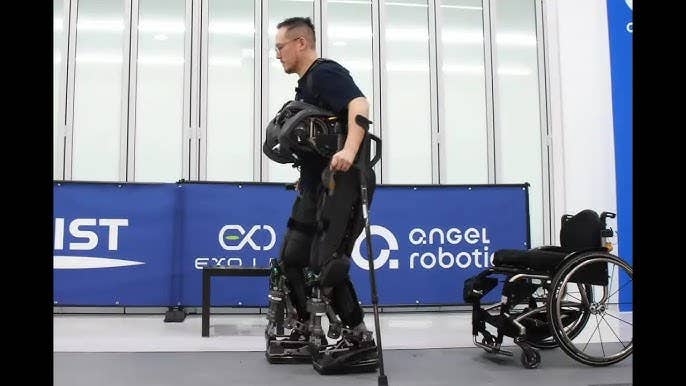Lifechanging robotic exoskeleton walks autonomously and puts itself on
KAIST unveils WalkON Suit F1, a wearable robot empowering paraplegics to transfer independently from wheelchairs, redefining mobility support

WalkON Suit F1, an advanced wearable robot for paraplegics that offers autonomous wheelchair-to-suit transfers. (CREDIT: KAIST)
KAIST researchers recently unveiled the latest version of their wearable robot, WalkON Suit F1, specifically designed to support individuals with complete paralysis. Unlike previous models, the F1 version can approach users and allow them to don the suit independently, removing the need for assistance from others.
This innovative advancement enables users to transfer directly from their wheelchairs into the suit seamlessly, marking a major milestone in the evolution of wearable technology for paraplegic individuals.
Developed by Professor Kyoungchul Kong, founder and CEO of Angel Robotics and a professor at KAIST’s Department of Mechanical Engineering, WalkON Suit F1 represents the culmination of nearly a decade of research aimed at enhancing mobility for people with severe spinal injuries.
Since 2015, Kong’s team has focused on improving WalkON to assist those with the most severe grade of paraplegia according to the American Spinal Injury Association (ASIA) Impairment Scale – grade A, which denotes complete paralysis. Unlike other wearable robots designed for rehabilitation or muscle assistance, the WalkON Suit is uniquely tailored for full paraplegic support, setting it apart in the wearable robotics field.
The journey of WalkON began with its first prototype in 2016 and advanced significantly with the release of WalkON Suit 4 in 2020, which enabled users to walk at a speed of 3.2 km/h, a pace comparable to the average walking speed of an able-bodied person.
That model could navigate obstacles typically encountered in daily life, such as narrow hallways, doors, and stairs. However, it shared a common limitation with other wearable robots: users required external assistance to put it on. Once in the suit, users could move independently, but initial setup always needed a helping hand.
Related Stories
WalkON Suit F1 addresses this limitation by incorporating a “frontal-docking” approach, a method that lets the user transfer directly from a wheelchair to the suit without assistance. The suit itself approaches the user autonomously, thanks to advanced robotic mobility functions.
It’s also equipped with an active weight balance system, allowing it to maintain stability, even when the user exerts force against it. Professor Hyunjoon Park from KAIST’s Department of Industrial Design contributed to the suit's unique aesthetic, blending a humanoid robot's appearance with functional elements to create a cutting-edge wearable device.
In addition to user independence, WalkON Suit F1 includes improved balance control, allowing wearers to use both hands freely in an upright position without relying on a cane. This advancement enables users to take several steps at a time with greater stability, offering a level of autonomy previously unavailable to people with complete paralysis.
At a technological level, WalkON Suit F1 introduces numerous performance upgrades. In partnership with Angel Robotics, the team ensured that all core components, including the motor, reducer, motor driver, and main circuit, are domestically produced.
The motors and reducers in F1 are twice as efficient as those in previous models, based on power-to-weight ratios, while the motor driver’s control speed has tripled, surpassing the best available international technologies. Additionally, a refined software system stabilizes the suit’s advanced motion control without the need for costly high-level controllers.
New features such as a visual recognition system for obstacle detection and an AI board for neural network applications enhance the suit's capacity to adapt to real-world environments.
Professor Kong emphasized the significance of WalkON Suit F1, describing it as “the culmination of wearable robot technology for the disabled.” He added, “The numerous components, control, and module technologies derived from WalkON Suit are setting the standard for the entire wearable robot industry.” WalkON’s technological advancements mark a leap forward not only for individual users but also for the wearable robotics field at large.
The launch of WalkON Suit F1 coincides with KAIST’s participation in the 3rd Cybathlon, an international competition often referred to as the “cyborg Olympics.” Kong’s lab, known as the Exo Lab, won first place in this event’s wearable robotics category in 2020, and the team now returns with the F1 suit, hoping to demonstrate the advanced capabilities of their technology.
Jeongsu Park, a Ph.D. student leading the KAIST team, expressed their goal to "show the technological gap rather than competing for rankings,” reflecting the team’s confidence in WalkON Suit F1’s capabilities.
This year’s Cybathlon, which was be held on October 27, introduced tougher challenges and an increase in tasks from six to ten, a change some had criticized as overly challenging. KAIST’s entry was be piloted by Seunghwan Kim, a staff researcher with complete paralysis.
The competition was held in a hybrid format, with some teams participating in person in Switzerland and others, including KAIST, broadcasting live from their own facilities. The KAIST team will compete from Angel Robotics’ Advanced Research Institute in Daejeon, South Korea, showcasing the WalkON Suit F1 in real-time as it navigates a course designed to test the limits of wearable robotics technology.
As the wearable robotics field evolves, the innovations seen in the WalkON Suit F1 underscore KAIST’s commitment to advancing mobility solutions for those with severe disabilities. By enabling greater independence and improving performance, WalkON Suit F1 not only enhances users’ quality of life but also pushes the boundaries of what wearable robotics can achieve.
Note: Materials provided above by The Brighter Side of News. Content may be edited for style and length.
Like these kind of feel good stories? Get The Brighter Side of News' newsletter.



